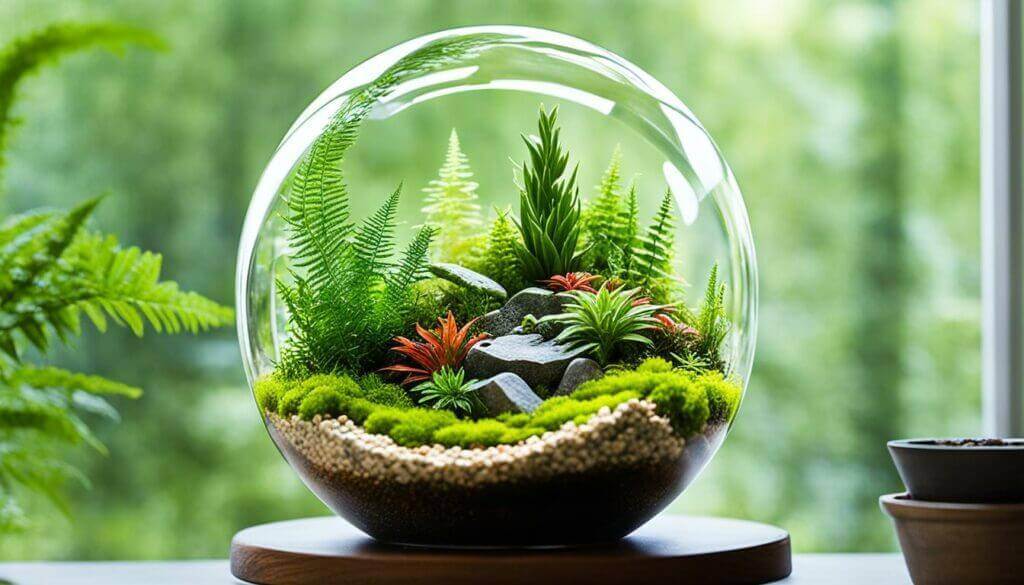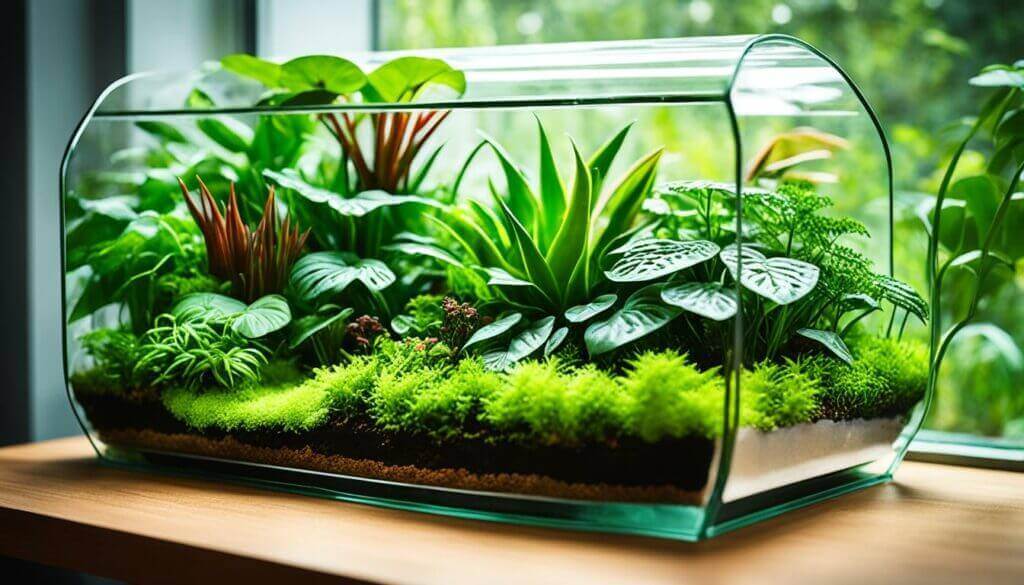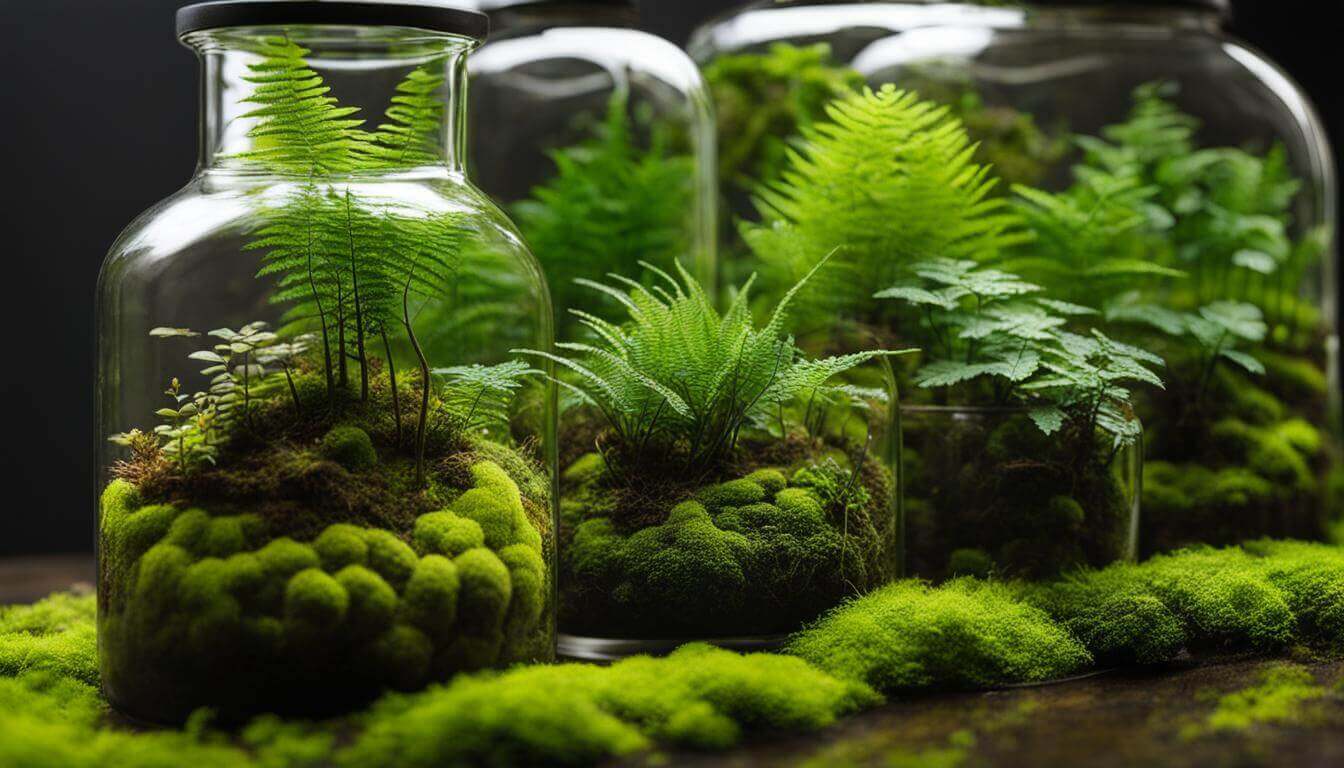Welcome to the world of terrariums, where you can create your very own miniature garden filled with beautiful and fascinating plants. Whether you have a closed terrarium that mimics a lush tropical environment or an open terrarium that replicates a desert habitat, choosing the right plants is essential for your terrarium’s success.
When it comes to terrarium plants, you want ones that are low maintenance, slow growing, and compact. In this article, we will explore the best terrarium plants that will thrive in your miniature world, whether it’s a closed or open terrarium.
Key Takeaways:
- Choose terrarium plants that are low maintenance, slow growing, and compact.
- For closed terrariums, opt for tropical plants that thrive in warm, humid environments with low light.
- Examples of suitable closed terrarium plants include nerve plants, asparagus setaceus, mosses, peperomias, polka dot plants, pileas, and more.
- In open terrariums, consider plants that can tolerate drier conditions, such as air plants, haworthia, jade plants, button ferns, and others.
- Remember to choose plants that will fit well in your terrarium space and thrive in the specific conditions of your chosen terrarium type.
What are Terrarium Plants?
Terrarium plants are plants specifically chosen for growing in a terrarium, which is a house plant display grown in a container, usually made of glass. Terrariums are arranged as miniature gardens and provide a different growing environment compared to the outside. The selection of terrarium plants depends on whether the terrarium is sealed or open.
Sealed terrariums create a warm and humid environment, making them suitable for tropical plants that thrive in moist habitats with indirect sunlight. On the other hand, open terrariums have lower humidity levels, making them ideal for desert plants that require drier conditions and less maintenance.
Terrarium plants should be low maintenance, slow growing, and compact to fit well in the limited space of the terrarium. They contribute to the overall aesthetic appeal of the display, creating a beautiful house plant arrangement that brings a touch of nature indoors.
House Plant Display as Miniature Gardens
Terrariums serve as attractive house plant displays that resemble miniature gardens. The glass container allows for transparency, giving you a clear view of your green creation from all angles. The careful arrangement of terrarium plants, along with decorative elements like pebbles, colored sand, or miniature figurines, adds a personal touch to the display.
Creating a terrarium is like cultivating a tiny world of lush greenery within the confines of a glass container.
Whether you choose a sealed or open terrarium, these miniature gardens provide a unique and captivating focal point in any room. They are a great way to showcase your green creativity while incorporating the benefits of indoor plants into your home decor.
Suitable Plants for Closed Terrariums
Closed terrariums create a miniature tropical climate with **warm, humid conditions** and **low light**. These conditions are ideal for **tropical plants** that thrive in moist habitats with indirect sunlight. Some suitable plants for closed terrariums include:
- Nerve plants
- Asparagus setaceus
- Mosses
- Peperomias
- Polka dot plants
- Pileas
- Creeping fig
- Arrowhead vines
- Spike moss
- Strawberry begonia
- Prayer plants
- Pothos
- African violets
- Earth star plants
- Jewel orchids
These plants are **compact, slow-growing**, and **low maintenance**, making them perfect for closed terrariums.
Suitable Plants for Open Terrariums
Open terrariums provide a different growing environment compared to closed terrariums. With lower humidity levels and drier conditions, they are ideal for plants that prefer a desert-like habitat. If you’re looking to create an open terrarium, here are some suitable plants that can thrive in these conditions:
Desert Plants:
- Cacti
- Succulents
- Jade plants
Air Plants:
- Air plants are unique plants that do not require soil to grow. They absorb moisture and nutrients from the air and are perfect for open terrariums.
Other Suitable Plants:
- Haworthia – A low-growing succulent with fleshy leaves that form a rosette shape.
- Button ferns – These ferns have small, button-like leaflets and can add a delicate touch to your terrarium.
- String of pearls – With their cascading trails of small bead-like leaves, string of pearls plants can create a stunning visual display in your terrarium.
- Chinese money plants – Also known as Pilea peperomioides, these plants have round, coin-shaped leaves and are said to bring good luck and prosperity.
- Creeping figs – These fast-growing vines can add a beautiful draping effect to your terrarium.
- Mexican snowball – With its compact, spherical shape and pale green leaves, the Mexican snowball is an eye-catching addition to any terrarium.
- Stonecrop – This succulent plant features fleshy leaves and clusters of small, star-shaped flowers.
These plants are not only low maintenance but also have adaptations that allow them to tolerate drier conditions. They can thrive with less frequent watering and can handle more light exposure compared to plants that require higher humidity levels.
Understanding Terrariums: Open and Closed Types
When venturing into the world of terrariums, it’s important to understand the two main types: open and closed. Each type offers a unique environment for your plants to thrive, catering to their specific needs and creating a visually stunning display.
Open Terrariums: Emulating Arid Conditions
Open terrariums are characterized by their ability to allow air circulation, which creates a drier environment within the container. This type of terrarium mimics the arid conditions found in desert regions, making it an ideal choice for plants that prefer lower humidity levels. In an open terrarium, you can cultivate desert plants such as cacti, succulents, jade plants, and small desert shrubs. These plants are adapted to thrive in drier conditions, requiring less frequent watering and lower maintenance overall.
Closed Terrariums: Creating Self-Contained Ecosystems
Closed terrariums, on the other hand, are sealed containers that create a self-contained ecosystem. The lack of air circulation in a closed terrarium leads to higher humidity levels, which is particularly beneficial for tropical plants that thrive in moist, humid conditions. The closed environment acts as a miniature tropical climate, providing the perfect growing conditions for plants such as ferns, mosses, air plants, and other humidity-loving species. These plants will flourish within the self-contained ecosystem, creating a lush and vibrant display.
Closed terrariums act as miniature tropical climates, while open terrariums mimic arid conditions.
The choice between an open or closed terrarium ultimately depends on the type of plants you wish to grow and the specific conditions they require. Consider the humidity needs of your chosen plant species and the overall aesthetic you wish to achieve.

By understanding the differences between open and closed terrariums, you can select the right environment for your plants and create a captivating miniature world within your chosen container. Whether you prefer the arid beauty of an open terrarium or the lush greenery of a closed terrarium, terrarium gardening offers endless possibilities for creativity and botanical enjoyment.
A Comparison of Open and Closed Terrariums
| Aspect | Open Terrariums | Closed Terrariums |
|---|---|---|
| Humidity Levels | Low | High |
| Air Circulation | Ample | Limited |
| Best Plant Choices | Cacti, succulents, desert plants | Tropical plants, ferns, mosses |
| Maintenance Requirements | Low | Low |
4 Essential Aspects of Terrarium Care
Proper terrarium care involves four key aspects: light requirements, ventilation needs, watering guidelines, and pruning and cleaning. By attending to these aspects, you can maintain the health and beauty of your terrarium plants.
Light Requirements
The amount of light your terrarium needs depends on whether it is a closed or open terrarium. Closed terrariums should be placed in areas with low to medium light levels to replicate a humid environment. On the other hand, open terrariums can tolerate more light exposure due to their lower humidity levels. Be mindful of the specific lighting needs of your plants and ensure they receive the appropriate amount of light for optimum growth.
Ventilation Needs
Proper ventilation is essential for the overall well-being of your terrarium plants. Open terrariums naturally provide better airflow, ensuring that your plants receive the oxygen they need. If you have a closed terrarium, periodically open the lid to allow fresh air to circulate. This helps prevent the growth of mold and maintains a healthy environment for your plants.
Watering Guidelines
The frequency of watering your terrarium depends on whether it is a closed or open terrarium. Closed terrariums, being self-contained ecosystems, require less frequent watering due to the moisture trapped inside. On the other hand, open terrariums may need more regular watering to compensate for the drier conditions. Monitor the soil moisture and adjust your watering schedule accordingly to prevent over or under watering.
Pruning and Cleaning
Regular pruning and cleaning are essential for the maintenance of your terrarium. Trim any dead or overgrown foliage to promote healthier growth and maintain the overall appearance of your plants. Additionally, keep an eye out for any debris or dust that may accumulate on the terrarium’s glass walls. Gently wipe them clean with a soft cloth to ensure maximum visibility and aesthetic appeal.
By paying attention to these four essential aspects of terrarium care – light requirements, ventilation needs, watering guidelines, and pruning and cleaning – you can create a thriving and visually stunning miniature garden.
Best Plants for Open Terrariums
If you’re looking to create an open terrarium that requires minimal maintenance and prefers drier conditions, there are several plant options that fit the bill. These plants are both aesthetically pleasing and easy to care for, making them perfect for beginners or those with busy schedules.
Air Plants

Air plants, also known as Tillandsias, are unique and fascinating plants that don’t require soil to grow. They absorb nutrients and moisture from the air, making them ideal for open terrariums. Their low maintenance needs and ability to tolerate drier conditions make them a popular choice among terrarium enthusiasts.
Haworthia
Haworthia plants are small, succulent-like plants that thrive in arid conditions. They have distinctive rosette-shaped leaves and come in various colors and patterns. Haworthias are known for their ability to adapt to different light conditions, making them great for open terrariums.
Jade Plants
Jade plants, also known as Crassula ovata, are versatile and hardy succulents. They have thick, fleshy leaves that store water, allowing them to survive in drier conditions. Jade plants are low maintenance and can add a touch of elegance to your open terrarium.
Button Ferns
Button ferns are compact and delicate ferns that thrive in drier conditions. They have small, round leaflets that give them a unique appearance. Button ferns are perfect for open terrariums due to their ability to tolerate lower humidity levels.
String of Pearls
String of Pearls, also known as Senecio rowleyanus, is a trailing succulent with long, trailing stems covered in small, spherical leaves that resemble pearls. They can tolerate drier conditions and require infrequent watering, making them a great choice for open terrariums.
Chinese Money Plants
Chinese Money Plants, also known as Pilea Peperomioides, are trendy and easy-to-care-for plants. Their unique round-shaped leaves and upright growth habit make them visually appealing. Chinese Money Plants can tolerate drier conditions and require less frequent watering, making them ideal for open terrariums.
Creeping Figs
Creeping figs are versatile plants that can adapt to different environments, including open terrariums. They have small, heart-shaped leaves that create a lush, cascading effect. Creeping figs can tolerate low humidity levels and require minimal care.
Mexican Snowball
Mexican Snowball, also known as Echeveria elegans, is a beautiful succulent with rosettes of pale green, fleshy leaves. It has a compact growth habit and can tolerate drier conditions. Mexican Snowball is a low maintenance plant that adds texture and visual interest to an open terrarium.
Stonecrop
Stonecrop, also known as Sedum, is a diverse group of succulents that come in various shapes, colors, and textures. They are drought-tolerant and low maintenance, making them perfect for open terrariums. Stonecrop plants add a unique touch to your terrarium with their interesting foliage and flowers.
In summary, open terrariums are an excellent choice for plants that prefer drier conditions and require low maintenance. Air plants, haworthia, jade plants, button ferns, string of pearls, Chinese money plants, creeping figs, Mexican snowball, and stonecrop are all suitable options for your open terrarium. These plants will thrive in the drier environment and add beauty and life to your miniature garden.
Selecting the Right Container
Choosing the right container is crucial for your terrarium. Glass containers, such as jars and bottles, are popular choices due to their transparency, allowing you to admire your miniature garden from all angles. When selecting a container, consider the size and design that will fit well in your living space. Ensure that the container can be sealed if creating a closed terrarium.
Essential Materials and Tools
Before assembling your terrarium, it’s important to gather all the essential materials and tools you’ll need to create a beautiful and thriving miniature ecosystem. Here are the key items you should have:
1. Substrate
To ensure proper drainage and create a healthy environment for your plants, you’ll need a suitable substrate. Good options to consider are gravel or activated charcoal, which help prevent waterlogging and maintain optimal moisture levels.
2. Potting Soil
Using high-quality potting soil specific to your plant choices is crucial for their growth and well-being. Make sure to choose soil that is appropriate for the types of plants you’ll be cultivating in your terrarium.
3. Decorative Elements
Add a touch of creativity and personalization to your terrarium with decorative elements. Consider using pebbles, colored sand, miniature figurines, or seashells to enhance the visual appeal and create a unique and captivating display.
4. Planting Tools
To make the planting process easier and more precise, it’s recommended to have a few essential tools on hand. Long-handled tweezers are ideal for placing small plants or adjusting decorations. A spray bottle allows you to provide water without over-saturating the soil, while a small shovel is necessary for planting and arranging the substrate.
Having these essential materials and tools ready before you start assembling your terrarium will ensure a smooth and enjoyable process. Take your time to gather everything you need, and let your creativity flourish as you create your own miniature green oasis.
Choosing Suitable Plants
When creating your terrarium, it’s important to choose plants that not only align with your maintenance preferences but also thrive in the specific conditions of your terrarium. Whether you’re a beginner or prefer low-maintenance plants, there are options to suit every terrarium type.
Low-Maintenance Plants for Beginners
If you’re new to terrarium gardening or simply prefer plants that require minimal effort, consider starting with ferns, pothos, or spider plants. These plants are known for their resilience and adaptability, making them perfect choices for low-maintenance terrariums.
Plants for Closed Terrariums
In closed terrariums, where humidity levels are higher, it’s important to select plants that thrive in moist environments. Ferns, mosses, and air plants are excellent options for closed terrariums. They love the increased moisture and indirect light found within these self-contained ecosystems.
Plants for Open Terrariums
If you have an open terrarium with drier conditions, you’ll want plants that can tolerate lower humidity levels. Succulents, cacti, and small desert shrubs are well-suited for open terrariums. These plants have adapted to arid environments and require less frequent watering.
| Plant Type | Recommended for |
|---|---|
| Ferns | Closed Terrariums |
| Mosses and Air Plants | Closed Terrariums |
| Succulents and Cacti | Open Terrariums |
| Small Desert Shrubs | Open Terrariums |
Remember to consider the space available in your terrarium and choose plants that fit well within it. This will ensure that your terrarium remains visually appealing and doesn’t become overcrowded. With the right plant selection, your terrarium will thrive and bring the beauty of nature into your home.
Conclusion
Terrariums offer a unique and creative way to bring the beauty of nature into your home. With their minimal maintenance requirements, they are perfect for busy individuals or those with limited gardening experience. Not only do terrariums enhance the aesthetics of any room, but they also offer a range of benefits.
One of the main advantages of terrariums is their ability to reduce stress and promote relaxation. Studies have shown that being around plants can have a calming effect on the mind, creating a peaceful atmosphere in your living space. Additionally, terrariums act as natural air purifiers, filtering out toxins and improving air quality.
Terrariums also provide educational opportunities, allowing you to observe and learn about the life cycle of plants in a miniature ecosystem. They can be a source of inspiration for aspiring gardeners and a fun way to teach children about the importance of caring for our environment.
Furthermore, terrariums make fantastic personalized gifts. With endless possibilities for customization, you can create a one-of-a-kind terrarium tailored to the recipient’s taste and style. From selecting the container and plants to adding decorative elements, each terrarium becomes a unique work of art.
Lastly, joining a terrarium enthusiast community can enhance your terrarium experience. Connecting with like-minded individuals who share your passion for greenery can inspire new ideas, offer helpful tips and tricks, and provide a sense of belonging. It’s a wonderful way to expand your knowledge and creativity in the world of terrarium gardening.
So why not embrace the world of terrariums and unlock your green creativity? Whether you’re looking for a beautiful addition to your home, a thoughtful gift, or a way to connect with others, terrariums offer endless possibilities for enjoyment and self-expression. Start your terrarium journey today and discover the joy of creating your own miniature garden.
